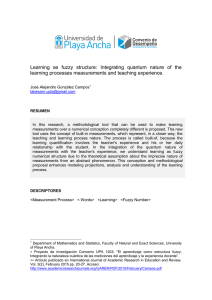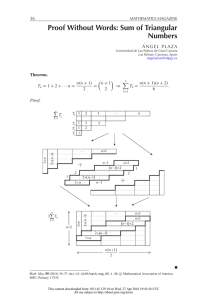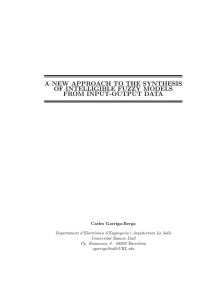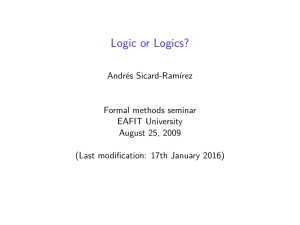TIC2001-1577-C03
Anuncio
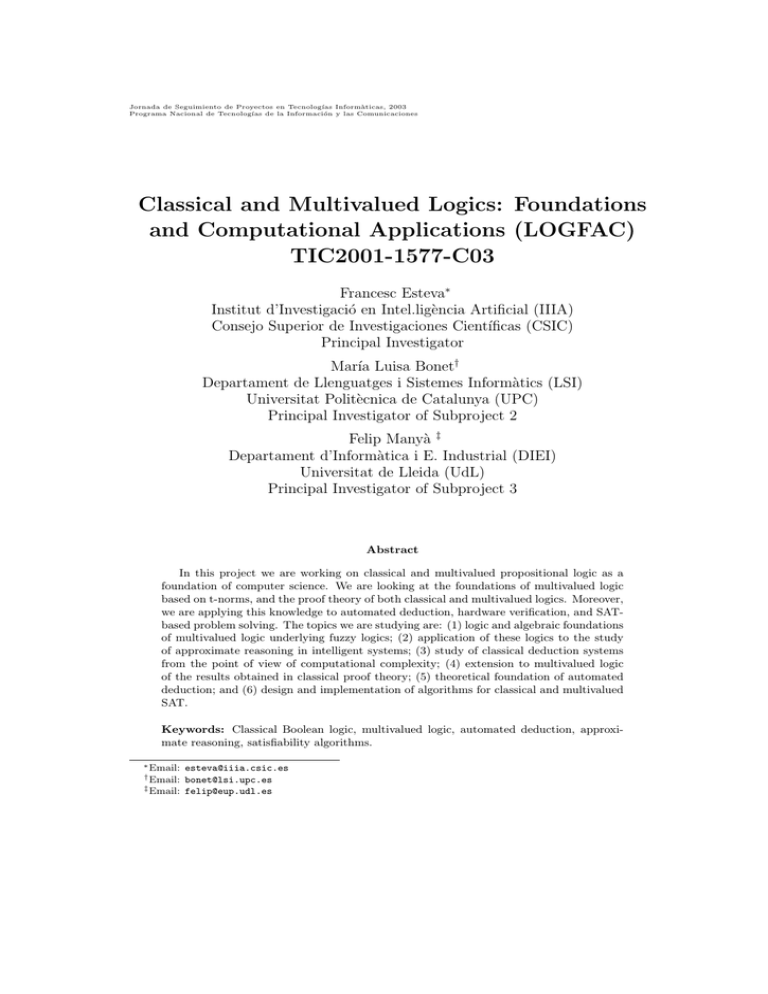
Jornada de Seguimiento de Proyectos en Tecnologı́as Informàticas, 2003 Programa Nacional de Tecnologı́as de la Información y las Comunicaciones Classical and Multivalued Logics: Foundations and Computational Applications (LOGFAC) TIC2001-1577-C03 Francesc Esteva∗ Institut d’Investigació en Intel.ligència Artificial (IIIA) Consejo Superior de Investigaciones Cientı́ficas (CSIC) Principal Investigator Marı́a Luisa Bonet† Departament de Llenguatges i Sistemes Informàtics (LSI) Universitat Politècnica de Catalunya (UPC) Principal Investigator of Subproject 2 Felip Manyà ‡ Departament d’Informàtica i E. Industrial (DIEI) Universitat de Lleida (UdL) Principal Investigator of Subproject 3 Abstract In this project we are working on classical and multivalued propositional logic as a foundation of computer science. We are looking at the foundations of multivalued logic based on t-norms, and the proof theory of both classical and multivalued logics. Moreover, we are applying this knowledge to automated deduction, hardware verification, and SATbased problem solving. The topics we are studying are: (1) logic and algebraic foundations of multivalued logic underlying fuzzy logics; (2) application of these logics to the study of approximate reasoning in intelligent systems; (3) study of classical deduction systems from the point of view of computational complexity; (4) extension to multivalued logic of the results obtained in classical proof theory; (5) theoretical foundation of automated deduction; and (6) design and implementation of algorithms for classical and multivalued SAT. Keywords: Classical Boolean logic, multivalued logic, automated deduction, approximate reasoning, satisfiability algorithms. ∗ Email: [email protected] [email protected] ‡ Email: [email protected] † Email: TIC2001-1577-C03 1 Objectives of the Project The objectives of the project are the following ones: • Logical and algebraic study of t-norm-based residuated multivalued logics. Our objectives are both in the algebraic semantics for the family of t-norm based manyvalued logics as well as in the corresponding varieties and the logical interpretation of the results obtained. We are also interested in studying these logics in relation to residuated and substructural logics which, starting from different motivations, are at the roots of the most general t-norm based many-valued logic, namely MTL, the logic of left-continuous t-norms and their residua. • Foundations of approximate reasoning in the framework of t-norm-based residuated multivalued logics. One objective is, following preliminary results already obtained, to explore the use of some t-norm based many-valued logics as a logical framework where to define modal theories corresponding to different uncertainty logics, like probabilistic reasoning, possibilistic logic or a belief function logic. This approach can also be used to get a formalization of similarity-based reasoning. Another objective is to deepen into the formalization of different aspects of fuzzy logic in a broad sense, like fuzzy rules or modifiers, which are not explicitly dealt in the above systems of many-valued logic. These aspects are very important for defining practical systems of approximate reasoning. • Proofs of lower bounds for propositional proof systems. The relationship between the complexity classes P and NP is fundamental in computer science. It is known that NP6=Co-NP if and only if for every propositional proof system there is a class of tautologies that requires superpolynomial size proofs (respect to the size of the tautology) in that system. Therefore if we were able to prove for every propositional proof system such lower bounds, then NP6=Co-NP, and because the class P is closed under complement, P6=NP. For some quite strong propositional proof systems classes of tautologies that require long proofs are known. We want to continue proving such results for stronger propositional proof systems. Also we want to study the comparative strength between systems, to be able to obtain a better classification. • Theoretical analysis of the limits of automated theorem proving. We expect that the complexity classes P, NP and Co-NP are different. Therefore, as a conclusion of what we have said in the previous item, we expect that for every proof system there will be classes of tautologies that will require superpolynomial size proofs. This is really bad news for propositional automated theorem provers. This is because for some tautologies, only to be able to write down their proofs we will need exponential time. As a consequence we propose a different attack. The question is: what happens with tautologies that have short proofs in some proof system? Can we come up with an algorithm that finds these quickly? Bonet-Pitassi-Raz proposed the following definition. TIC2001-1577-C03 A proof system P is automatizable if there is an algorithm that given a formula, it finds a proof of it in the system P in time polynomial in the size of the shortest P -proof of the formula. Bonet-Pitassi-Raz showed that some strong systems don’t have this property. We want to investigate if weaker systems like Resolution or Cutting Planes are automatizable. Also we want to study other robust notions related to automatizability, like feasible interpolation or less restrictive versions of automatizability, and see which proof systems have them. • Relationship between logical circuits and proof theory. A proof line for some propositional proof system corresponds to a type of circuit. This relationship has helped show that some formulas require long proofs in some propositional proof systems using lower bounds on the corresponding circuits. Also it has helped give small proofs in some other cases. It would be interesting to study this relationship better, not only for theoretical purposes, but also for applications. Good algorithms for automated deduction can help to do circuit verification. • SAT-based problem solving. Motivated by the success of the generic problem solving approach that consists of translating a given problem into Boolean propositional satisfiability (SAT), solving it with a fast SAT solver and mapping the solution back into the original problem, our goal is to investigate the benefits one can gain by using multivalued SAT solvers and encodings. To this end, we will study logical and complexity aspects of different multivalued clausal form formalisms, design and implement competitive multivalued SAT solvers, and apply the multivalued SAT-based problem solving approach to solve real-world problems. • Phase transition phenomenon in multivalued SAT problems. The study of search behavior of random SAT formulas has provided tremendous insights into the hardness nature of combinatorial problems, beyond the worst-case notion of NPcompleteness. In particular, such studies have uncovered an interesting phase transition behavior between an area in which most instances are solvable and one in which most of the instances are unsolvable. The critically constrained area, where the hardest instances occur, coincides with the phase transition. Our goal is to identify similar phase transition phenomena in multivalued SAT problems and provide a theoretical explanation of such phenomena. 2 Results of the Project The results obtained for each one of the objectives of the project are the next ones: • Logical and algebraic study of t-norm-based residuated multivalued logics. In the framework of the Basic Fuzzy logic BL, the logic defined by Hájek to cope with the logic of continuous t-norms and its residuum, we have studied and axiomatized some subvarieties of the variety of the corresponding algebras (BL-algebras). In [28] and [29] we have studied the varieties V(C) generated by a BL-chain C belonging to a special TIC2001-1577-C03 class (called regular BL-chains) that contains the standard BL-chains (BL-chains defined on [0,1] by a continuous t-norm and its residuum). We have proved that each such subvariety is finitely axiomatizable and that the family of subvarieties V(C) for C regular is countable. Moreover we have provided algorithms to check embedding between subvarieties of the family and to find the set of equations Eq(C) defining V(C). This last result is specially important since, in particular, we obtain in this way all the axiomatic extensions of BL logic that are standard complete with respect to any standard BL-chain. In other words, we have obtained an axiomatization of any fuzzy logic in a narrow sense relative to a continuous t-norm and its residuum. On the other hand, Esteva and Godo had recently defined the logic MTL, generalization of BL, proved to be the logic of left continuous t-norms (the most general t-norms having residuum) and their residua. In this framework we have studied several issues. Namely, in [30] we have addressed completeness problems of some axiomatic extensions of MTL, in [27] the falsehood-free fragment of MTL and BL, in [32] the axiomatic extensions of the Nilpotent Minimum logic, an extension in turn of MTL, in [25] the problem of definability of connectives, and finally in [26] we have studied the class of t-norm based logics in the framework of residuated and substructural logics. It is also worth mentioning a related work, [21], where completeness results and a proof theory for MTL are generalized to the axiomatic extension of MTL adding the n-contraction axiom (xn = xn+1 ). This work has been done in the framework of the Integrated Action HU2001-0030 between IIIA and the Logic Group of the Technical University of Vienna (Austria). • Foundations of approximate reasoning in the framework of t-norm-based residuated multivalued logics. We have studied three logical aspects of approximate reasoning. In [39] we have introduced a new class of fuzzy closure operators called implicative closure operators, which generalize most of the notions of fuzzy closure operators already introduced by different authors. We show that implicative closure operators capture most usual consequence relations used in Approximate Reasoning, in particular those which are based on the notion of similarity. In [35, 36, 22] we have studied the use of similarity relations in systems of implicative fuzzy rules for solving problems of coverage and inconsistency. We have shown how the notion of similarity can address these problems in a natural way and moreover in [23] we have shown how the similarity relation can be learned from the fuzzy system itself. Finally, in [1, 2] we have also contributed to further developments in the topic of an extended possibilistic logic framework which allows to deal with fuzzy object constants and which incorporates a fuzzy unification mechanism for such constants. • Proofs of lower bounds for propositional proof systems. We have proved lower bounds for various complexity measures related to propositional proof systems: size, space and rank. First of all we will discuss the size lower bounds, which consists in proving that some classes of tautologies require superpolynomial size proofs in some proof systems. In [15, 14, 24] we study the proof systems Res(k), which are extensions of Resolution that allow clauses with conjunctions of up to k literals. These systems are interesting also from TIC2001-1577-C03 the point of view of automated deduction, because they are stronger than Resolution. Given that general proof search algorithms produce tree-like refutations (each line is used at most once), we have also studied the complexity of tree-like Res(k). In [24] we show that Resolution is exponentially stronger than tree-like Res(k). This means that there is a class of tautologies that has polynomial size proofs in Resolution but require exponential size tree-like Res(k) size. Also in [24] we show exponential separations between Res(k) and Res(k + 1) for all k. In [14] we formulate a simple form of consistency and we show which proof systems among the Res(k) ones prove their own consistency or the consistency of other systems in polynomial size. Also we see that Resolution requires exponential size proofs of the formula that expresses its own consistency. The group has also worked with the measure of space. In [24] we prove space lower bounds for tautologies in the systems Res(k). In [17] a relationship between the space and the width is presented. The width of a refutation is the number of literals in the clause with the highest number of literals. [17] show that the width can be characterized in terms of game theory for expressivity in infinitary logic. As a consequence of this we were able to show that the space is never less than the width in Resolution. Finally we introduced the rank measure for the proof system Cutting Planes. This system translates sets of unsatisfiable clauses to linear inequalities, and uses certain inference rules to work with such inequalities. The sets of inequalities are polytopes without interior integer points. In [16, 20] we use linear programming techniques to study the Cutting Planes system, using the rank measure. The rank is the number of iterations of the cut rule until we obtain the integer hull of the polytope. In [16] we show that the rank measure corresponds to the depth of Cutting Planes refutations. In [16, 20] we prove lower bounds on the rank of the main used classes of tautologies. • Theoretical analysis of the limits of automated theorem proving. Our studies of the systems Res(k) and tree-like Res(k) are important to automated theorem proving. The conclusion that we obtained is that it is worthwhile to explore versions of proof search algorithms based on DLL and others that branch out on conjunctions of literals. On the other hand our study on the rank of Cutting Planes proof system gives us ideas on where to look for algorithms for cutting planes. In [16] we show that rank d implies treelike size O(nd ). So it would be interesting to come up with an algorithm that obtained refutations, based on allowing the rank to be increased step by step. • Relationship between logical circuits and proof theory. The close relationship between the theory of Boolean circuits and the theory of propositional proof complexity has been observed by a number of researchers more than once. Nonetheless, the established connections were empirical only, lacking a theoretical background. In the articles [13, 12] we achieve a precise provable relationship between the size of proofs in resolution of a propositional formula, and inexpressivity results in logical formalisms such as Datalog. These results, novel in both areas, suggest that the relationship between proof complexity and classical complexity is better understood through TIC2001-1577-C03 descriptive complexity theory than through Boolean circuit complexity. The discovery of this connection has been a surprise in both research areas, to the extent that it provided the tools to solve some problems that were left open in the literature for some time. In the article [17] we prove, using these techniques, that the resolution space is always bigger than the resolution width. The exact relationship between both measures remained unknown despite being well-known in the areas of resolution and automatic deduction. • SAT-based problem solving. We have defined resolution calculi for a wide range of many-valued clausal forms and have analyzed the complexity of their Horn-SAT and 2-SAT problems [5, 10]. Then, we have developed a multivalued local search SAT solver inspired by the Boolean SAT solver WalkSAT [9, 11], and two multivalued complete solvers inspired by zChaff [8] and Satz [7]. Finally, we have shown that multivalued SAT-based problem solving outperforms Boolean SAT-based problem solving in a considerable number of problems [9, 11, 8, 7]. This is due to the fact that multivalued SAT preserves and exploits better the structure of the problem, provides more powerful propagation techniques and gives rise to more compact encodings. We are now studying the competitiveness of multivalued SAT for hardware verification. • Phase transition phenomenon in multivalued SAT problems. We have identified phase transition phenomena for several multivalued SAT problems, and have studied empirically the interface between P and NP for such problems [6]. The instances of the hard region of the phase transition have been used to experimentally evaluate the multivalued SAT solvers developed. We are now investigating how to provide a theoretical explanation of such phenomena. 3 Indicators of Results 7 Ph.D. students are or have been working on the project: C. Ansótegui (UdL), J. Argelich (UdL), A. Atserias (UPC), J.L. Esteban (UPC), J. Larrubia (UdL), C. Noguera(IIIA-CSIC) and J. Planes (UdL). A. Atserias finished his Ph.D. thesis, “The Complexity of ResourceBounded Propositional Proofs”, at UPC in 2002. C. Ansótegui and J.L. Esteban will submit their Ph.D. thesis within the next two months. The results of the project have been published in books, conference proceedings and international journals. The list of publications appears in the References section. This section only contains the publications of the project. In addition to the publications presented in the conferences some members of the research team have given invited talks, have organized conferences and have been members of programme committees. F. Esteva gave invited talks in the Congreso Español de Lógica y Tecnologı́a Fuzzy (ESTYLF’02) and the Symposium on Fuzzy Logic associated to the International Congress of Logic, Methodology and Philosophy of Science. L. Godo gave an invited talk in the First International Workshop on Knowledge Representation and Approximate Reasoning (Olsztyn, Poland) and taught a course on Soft Computing at the Third International Summer School on Reasoning under Partial Knowledge (REASONPARK-03) in Perugia, Italia. J. Levy organized and chaired the 17th International Workshop on Unification (UNIF’03) in Valencia. TIC2001-1577-C03 A. Atserias gave invited talks in the 13th Annual Conference of the European Association for Computer Science in Karpacz, in the Workshop on the Satisfiability Problem in Dagstuhl, and in the Workshop on Typical Case Complexity and Phase Transition in Ottawa. The topics of the project have given rise to international collaborations. The IIIA-CSIC team has a project (acción integrada) with the group of Matthias Baaz of the Technical University of Wien, and a project with P. Hájek of the Czech Academy of Sciences. The UPC team has had a project (acción integrada HA 2000-41) with the group in Ulm (Germany) leaded by Jacobo Torán. The UdL team has a project with the group of Bart Selman and Carla Gomes from Cornell University (USA), funded by the Air Force Office for Scientific Research. Apart from these projects there are ongoing collaborations with Chu Min Li (Université de Picardie), R. Hähnle (Chalmers University), Toniann Pitasi (University of Toronto), Pavel Pudlak (Czech Academy of Sciences), D. Mundici (Univ. Florence), F. Montagna (Univ. Siena), B. Gerla (Univ. Salerno), etc. A remarkable effort has been devoted to the development of software. During this year, there has been implemented a local search multivalued SAT solver and two complete multivalued SAT solvers, one that incorporates look-ahead heuristics and one that incorporates look-back heuristics. References [1] T. Alsinet and L. Godo: Adding similarity-based reasoning capabilities to a Horn fragment of possibilistic logic with fuzzy constants. Fuzzy Sets and Systems. In press. [2] T. Alsinet, L. Godo and S. Sandri: Two formalisms of extended possibilistic logic programming with context-dependent fuzzy unification: A comparative description. Electronic Notes in Theoretical Computer Science, 66(5), 2002. [3] T. Alsinet, F. Manyà, and J. Planes: Improved branch and bound algorithms for Max-2SAT and weighted Max-2-SAT. In Proceedings of the Catalonian Conference on Artificial Intelligence, 2003. [4] T. Alsinet, F. Manyà, and J. Planes: Improved branch and bound algorithms for MaxSAT. In Proceedings of the 6th International Conference on the Theory and Applications of Satisfiability Testing, 2003. [5] C. Ansótegui, R. Béjar, A. Cabiscol, C. M. Li, and F. Manyà: Resolution methods for many-valued CNF formulas. In Fifth International Symposium on the Theory and Applications of Satisfiability Testing, SAT-2002, Cincinnati, USA, pages 156–163, 2002. [6] C. Ansótegui, R. Béjar, A. Cabiscol, and F. Manyà: The interface between P and NP in many-valued clausal forms. In Proceedings of the Catalonian Conference on Artificial Intelligence, 2003. [7] C. Ansótegui, J. Larrubia, C. M. Li, and F. Manyà: Mv-Satz: A SAT solver for manyvalued clausal forms. In 4th International Conference Journées de L’Informatique Messine, JIM-2003, Metz, France, 2003. TIC2001-1577-C03 [8] C. Ansótegui, J. Larrubia, and F. Manyà. Boosting Chaff’s performance by incorporating CSP heuristics. In 9th International Conference on Principles and Practice of Constraint Programming, CP-2003, Kinsale, Ireland, 2003. In press. [9] C. Ansótegui and F. Manyà: Bridging the gap between SAT and CSP. In 8th International Conference on Principles and Practice of Constraint Programming, CP-2002, Ithaca/NY, USA, pages 784–785. Springer LNCS 2470, 2002. [10] C. Ansótegui and F. Manyà: New logical and complexity results for Signed-SAT. In Proceedings, 33rd International Symposium on Multiple-Valued Logics (ISMVL), Tokyo, Japan, pages 181–187. IEEE CS Press, Los Alamitos, 2003. [11] C. Ansótegui, F. Manyà, R. Béjar, and C. Gomes: Solving many-valued SAT encodings with local search. In Proceedings of the Workshop on Probabilistics Approaches in Search, 18th National Conference on Artificial Intelligence, AAAI-2002, Edmonton (Canada), 2002. [12] A. Atserias: On sufficient conditions for unsatisfiability of random formulas. Journal of the ACM (accepted). [13] A. Atserias: Unsatisfiable random formulas are hard to certify. In Proceedings of the 17th IEEE Symposium on Logic in Computer Science (LICS), pages 275–284. IEEE Computer Society, 2002. [14] A. Atserias and M. L. Bonet: On the automatizability of resolution and related propositional proof systems. Information and Computation (accepted). [15] A. Atserias and M. L. Bonet: On the automatizability of resolution and related propositional proof systems. In Proceedings of the Annual Meeting of the European Association of Logic in Computer Science (CSL’02), volume 2471 of Lecture Notes in Computer Science, pages 569–583. Springer, 2002. [16] A. Atserias, M. L. Bonet, and J. Levy: On the chvatal rank and cutting planes proofs. Submitted. [17] A. Atserias and V. Dalmau: A combinatorial characterization of resolution width. In Proceedings of the 18th IEEE Conference on Computational Complexity (CCC), pages 239–247. IEEE Computer Society, 2003. [18] A. Atserias, N. Galesi, and P. Pudlak: Monotone simulations of nonmonotone proofs. Journal of Computer and System Sciences, 65:626–638, 2002. [19] E. Ben Sasson and N. Galesi: Space complexity of random formulae in resolution. Random Structures and Algorithms, 23(1):92–109, 2003. [20] J. Buresh-Oppenheim, N. Galesi, S. Hoory, A. Magen, and T. Pitassi: Rank bounds and integrality gaps for cutting planes procedures. In Proceedings of the IEEE Symposium on Foundations on Computer Science (FOCS 2003). IEEE Society (pending), 2003. [21] A. Ciabattoni, F. Esteva and L. Godo: T-norm based logics with n-contraction. Neural Network World 5 / 02 (2002), pp. 441-452. TIC2001-1577-C03 [22] I. Drummond, L. Godo and S. Sandri: Restoring consistency in systems of fuzzy gradual rules using similarity relations. In Advances in Artificial Intelligence: 16th Brazilian Symposium on Artificial Intelligence (SBIA 2002) (G. Bittencourt and G.L. Ramalho eds.), Recife (Brasil), November 2002. Lecture Notes in Artificial Intelligence 2507, pp. 386-396. [23] I. Drummond, L. Godo, and S. Sandri: Learning fuzzy systems with similarity relations. Proc. of the 10th IFSA World Congress (IFSA 2003), Istanbul (Turquı́a), Julio 1-4, 2003, pp. 516-523. [24] J. L. Esteban, N. Galesi, and J. Messner: On the complexity of resolution with bounded conjunctions. In Proceedings of the 29th International Colloquium on Automata, Languages and Programming (ICALP 2002), volume 2380 of Lecture Notes in Computer Science, pages 220–231. Springer Verlag, 2002. [25] F. Esteva, A. Garcia-Cerdaña and C. Noguera: On definability of maximum in leftcontinuous t-norms. Proc. EUSFLAT’03, September 2003, Zittaw (Germany) pp. 609-613. [26] F. Esteva, L. Godo and A. Garcia-Cerdaña: On the Hierarchy of t-norm based Residuated Fuzzy logic. In Beyond Two: Theory and Applications of Multiple-Valued Logic (E. Orlowska, M. Fitting eds.), Studies in Fuzziness and Soft Computing, Physica-Verlag (2003) pp. 251-272. [27] F. Esteva, L. Godo, P. Hájek and F. Montagna: Hoops and Fuzzy Logic. Journal of Logic and Computation, Vol. 13, No. 4, 2003, pp. 531-555. [28] F. Esteva, L. Godo and F. Montagna: Axiomatization of any residuated fuzzy logic defined by a continuous t-norm. In Fuzzy Sets and Systems - IFSA 2003, (T. Bilgic, B. De Baets and O. Kaynak eds.), Lecture Notes in Artificial Intelligence 2175 (2003), pp. 172-179. [29] F. Esteva , L. Godo and F. Montagna: Equational characterization of the subvarieties of BL generated by t-norm algebras. Studia Logica, to appear. [30] F. Esteva, J. Gispert, L. Godo and F. Montagna: On the standard and rational completeness of some extensions of the Monoidal t-norm based logic. Studia Logica vol 71 (2002) pp 199-226. [31] R. Gavaldà and D. Thërien. Algebraic characterizations of small classes of boolean functions. In Proceedings of the 20th Annual Symposium on Theoretical Aspects of Computer Science (STACS 2003), volume 2607 of Lecture Notes in Computer Science. SpringerVerlag, 2003. [32] J. Gispert: Axiomatix extensions of the Nilpotent Minimum Logic. Logics Reports on Mathematical Logic 37, 2003 (en prensa). [33] J. Gispert and D. Mundici: MV-algebras: a variety for magnitudes with archimedian units. Submmited as survey. [34] L. Godo and S. Sandri: A note on the duality between continuous t-norm and t-conorm operators. In Proc. of the 12 th. IEEE Internationl Conference on Fuzzy Systems, FuzzIEEE’03, St. Louis (USA), 2003, 49-54. TIC2001-1577-C03 [35] L. Godo and S. Sandri: A similarity-based approach to deal with inconsistency in systems of fuzzy gradual rules. In Proc. of IPMU’02, Annecy (France), 1655–1662, 2002. [36] L. Godo and S. Sandri: Dealing with covering problems in fuzzy rule systems by similaritybased extrapolation. In Proc. of the 11 th. IEEE Internationl Conference on Fuzzy Systems, Fuzz-IEEE’02, Honolulu (USA), 2002, 723- 728. [37] J. Levy and M. Villaret: Currying Second-Order Unification Problems. In Rewriting Techniques and Applications, RTA’02, Copenhagen, Denmark, July 22-24, 2002. Lecture Notes in Computer Science 2378, pages 326-339. Springer-Verlag. [38] A. Lozano and G. Valiente: On the maximum common embedded subtree problem for ordered trees. Submitted. [39] R. Rodrı́guez, F. Esteva, P. Garcı́a and L. Godo: On Implicative Closure Operators in Approximate Reasoning. Int. Journal of Approximate Reasoning 33 (2003) 159-184.
